A Guide to the Most Beautiful Varieties of Black-Eyed Susan to Grow in Your Garden
Published: October 27, 2025 at 9:10:27 PM UTC
These North American native perennials aren't just pretty faces – they're also drought-tolerant, deer-resistant, and absolute magnets for butterflies and pollinators. Whether you're looking to brighten up borders, create stunning cut flower arrangements, or add reliable color to difficult garden spots, there's a Black-Eyed Susan variety perfect for your needs.
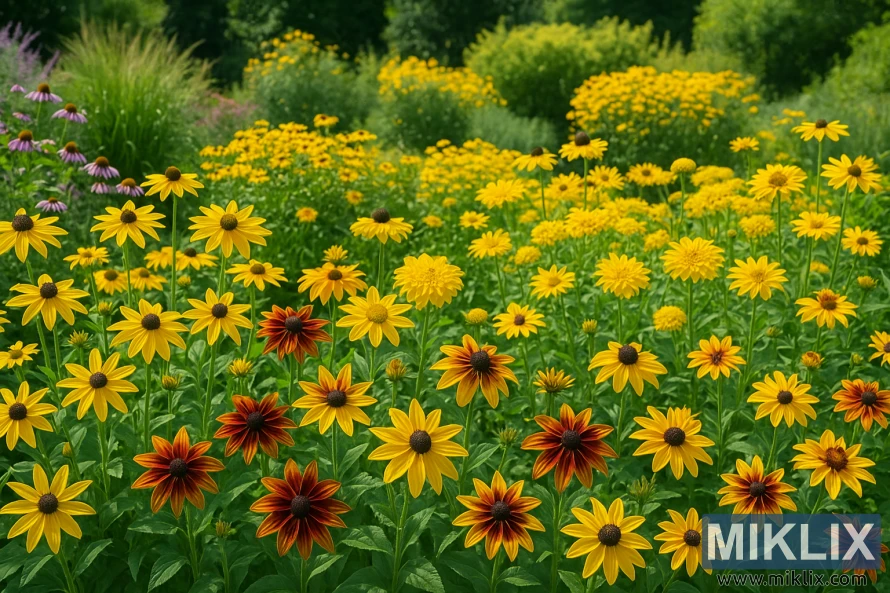
Picture a classic Black-Eyed Susan in your mind, and you'll likely envision a cheerful yellow flower with a dark center. But did you know there's actually a stunning variety of these beloved garden staples? From rich mahogany hues to quill-like petals and even green-eyed beauties, Black-Eyed Susans (Rudbeckia) offer far more diversity than many gardeners realize.
What Are Black-Eyed Susans?
Black-Eyed Susans belong to the Rudbeckia genus, which includes about 25 species native to North America. Their anatomy consists of ray florets (the colorful "petals") surrounding disk florets at the center (the "eye"). While the classic variety features golden-yellow petals with a dark brown or black center, modern cultivars offer an impressive range of colors, sizes, and petal formations.
Most Black-Eyed Susans are either short-lived perennials or self-seeding annuals that bloom from midsummer through fall. They thrive in full sun to partial shade and adapt to various soil conditions, making them incredibly versatile garden plants. Their resilience in hot, dry conditions has earned them a place in many low-maintenance garden designs.
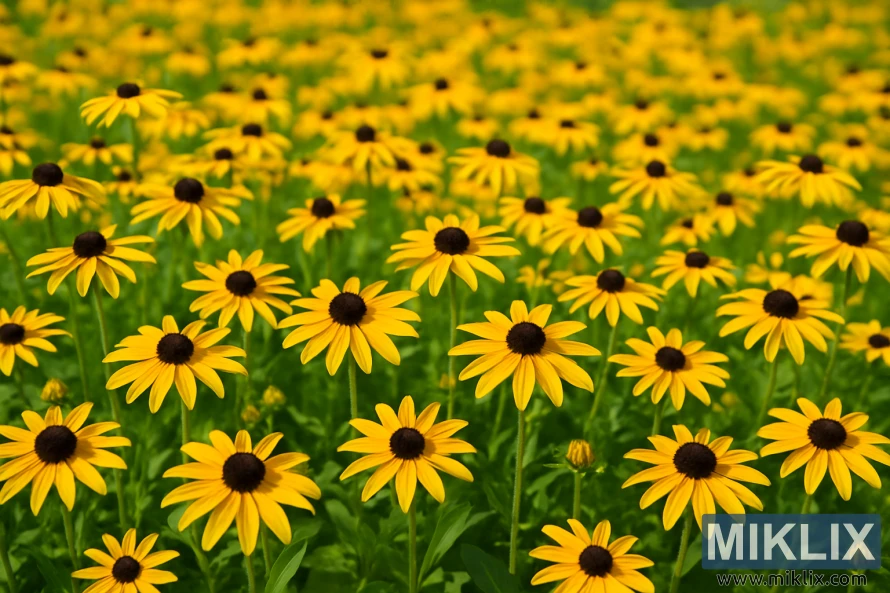
Common Black-Eyed Susan Species
- Rudbeckia hirta - The classic Black-Eyed Susan, often grown as an annual or biennial
- Rudbeckia fulgida - Sometimes called Orange Coneflower, a more reliably perennial species
- Rudbeckia triloba - Brown-Eyed Susan, featuring smaller but more numerous flowers
- Rudbeckia laciniata - Cutleaf Coneflower, a tall species with deeply lobed leaves
- Rudbeckia subtomentosa - Sweet Black-Eyed Susan, known for its fragrant blooms
- Rudbeckia maxima - Great Coneflower, featuring dramatic height and blue-green foliage
Benefits of Growing Black-Eyed Susans
Why You'll Love Black-Eyed Susans
- Drought-tolerant once established, requiring minimal watering
- Deer-resistant, making them perfect for gardens with wildlife pressure
- Pollinator-friendly, attracting butterflies, bees, and other beneficial insects
- Long blooming period from midsummer through fall
- Excellent cut flowers for fresh bouquets and dried arrangements
- Self-seeding capability ensures continuous garden presence
- Adaptable to various soil types and growing conditions
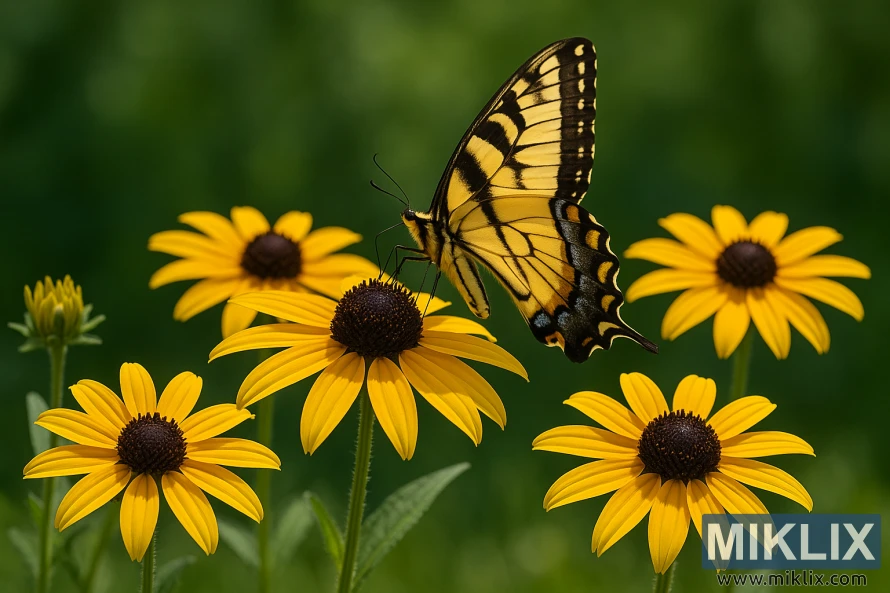
General Growing Requirements
Light
Most Black-Eyed Susans prefer full sun (6+ hours daily) but will tolerate partial shade. In hot southern climates, afternoon shade can be beneficial.
Soil
Adaptable to most soil types but prefer well-draining, moderately fertile soil. They'll tolerate poor soils but perform best with added organic matter.
Water
Water regularly until established. Once established, they're quite drought-tolerant, needing water only during extended dry periods.
10 Most Beautiful Black-Eyed Susan Varieties
Ready to discover the stunning diversity of Black-Eyed Susans? Here are ten exceptional varieties that will bring beauty and resilience to your garden landscape.
1. 'Goldsturm' (Rudbeckia fulgida)
The gold standard of Black-Eyed Susans, 'Goldsturm' features bright golden-yellow petals surrounding a prominent black center. This award-winning variety (Perennial Plant Association's Plant of the Year in 1999) grows 24-30 inches tall and blooms reliably from July through October.
What makes 'Goldsturm' special is its exceptional disease resistance, sturdy stems perfect for cutting, and true perennial nature. It forms tidy clumps that gradually spread to create impressive drifts of color. Plant it in borders, meadow gardens, or mass plantings for maximum impact.
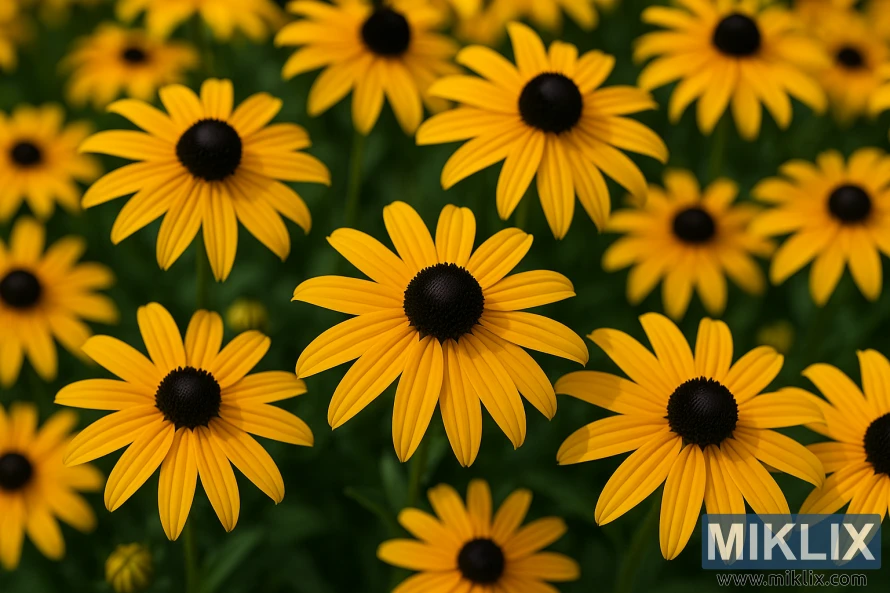
2. 'Cherokee Sunset' (Rudbeckia hirta)
This All-America Selections winner captures the spirit of a summer sunset with its remarkable color range. Each flower starts with deep mahogany at the base, transitioning through red and orange to yellow tips. The semi-double to fully double blooms reach up to 4 inches across on plants that grow 24-30 inches tall.
'Cherokee Sunset' performs as a short-lived perennial in warmer zones but is often grown as an annual. Its unique coloration makes it a standout in mixed borders and cutting gardens. The plants bloom profusely from midsummer through fall against attractive dark blue-green foliage.
Add these sunset-hued beauties to your garden with seeds or starter plants.
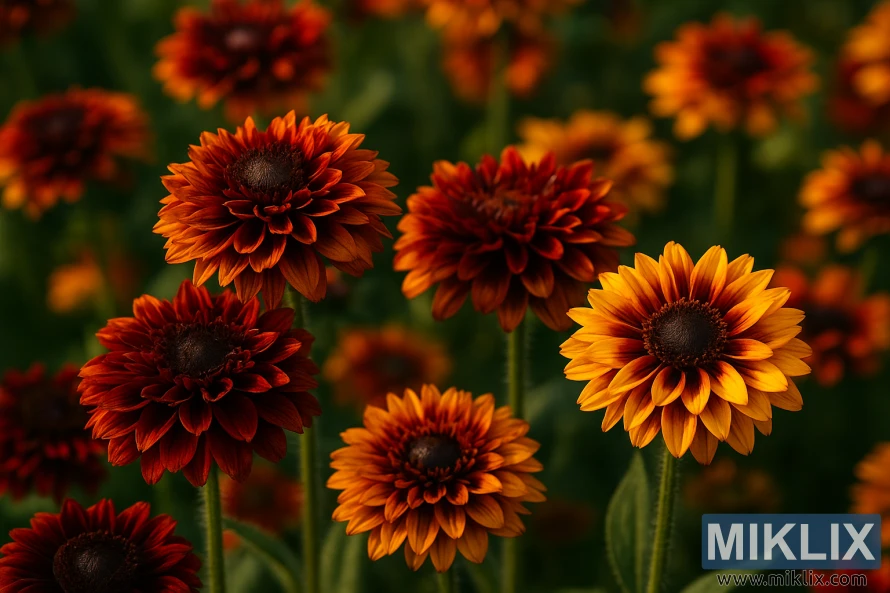
3. 'Prairie Sun' (Rudbeckia hirta)
For a truly unique Black-Eyed Susan, look no further than 'Prairie Sun.' This 2003 All-America Selections winner features golden yellow petals that fade to primrose yellow at the tips, all surrounding a striking light green center instead of the traditional brown or black.
Growing 30-36 inches tall, 'Prairie Sun' makes an excellent cut flower with its sturdy stems and 5-inch blooms. It performs as a tender perennial in warmer climates but is typically grown as an annual. The plants bloom from early summer until frost and are particularly striking when mass planted.
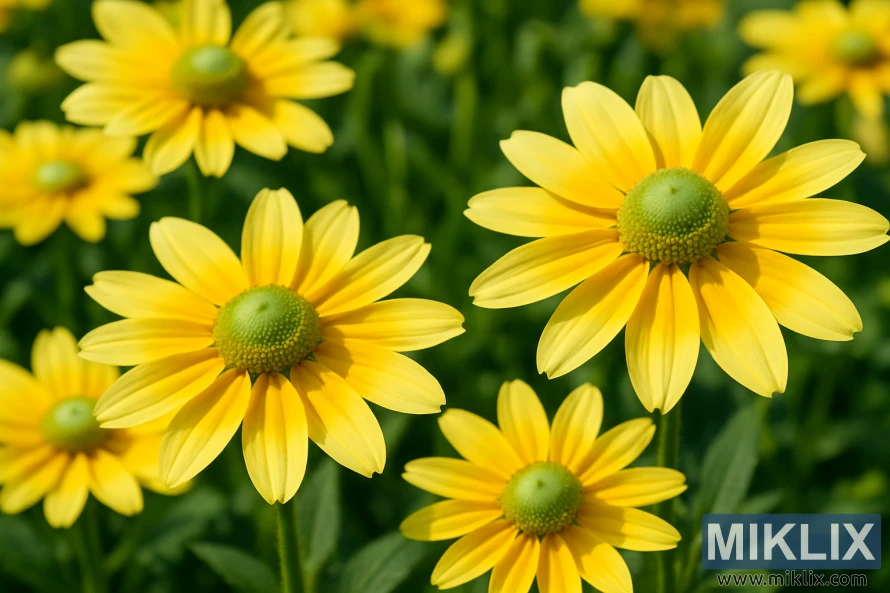
4. 'Cherry Brandy' (Rudbeckia hirta)
Break away from traditional yellow with 'Cherry Brandy,' the first red-flowered Black-Eyed Susan. This stunning variety features velvety cherry-red petals that deepen to crimson near the characteristic dark brown center. Growing 20-24 inches tall, it's perfect for adding unexpected color to borders and containers.
'Cherry Brandy' performs as a short-lived perennial in zones 5-8 but is often grown as an annual. It blooms from midsummer to fall and makes an excellent cut flower. The rich red tones pair beautifully with ornamental grasses and purple-flowering perennials.
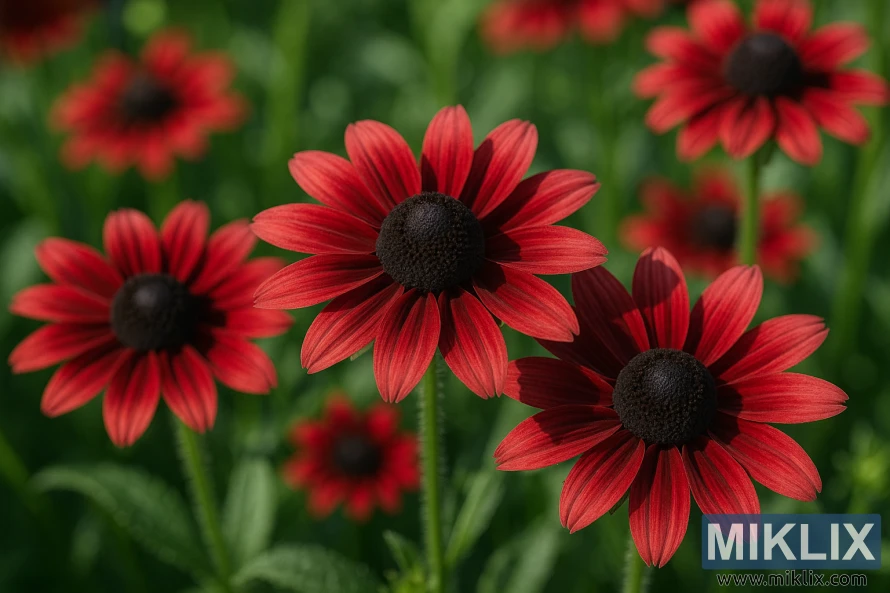
5. 'Henry Eilers' (Rudbeckia subtomentosa)
One of the most distinctive Black-Eyed Susans, 'Henry Eilers' features unusual quilled or tubular petals that create a star-like appearance. The bright golden-yellow rays surround a brown center on plants that can reach an impressive 3-5 feet tall.
This variety is a true perennial, returning reliably for years in zones 4-8. It blooms from late summer into fall and offers a sweet fragrance, something uncommon in most Black-Eyed Susans. The tall stems make it perfect for back borders and cutting gardens.
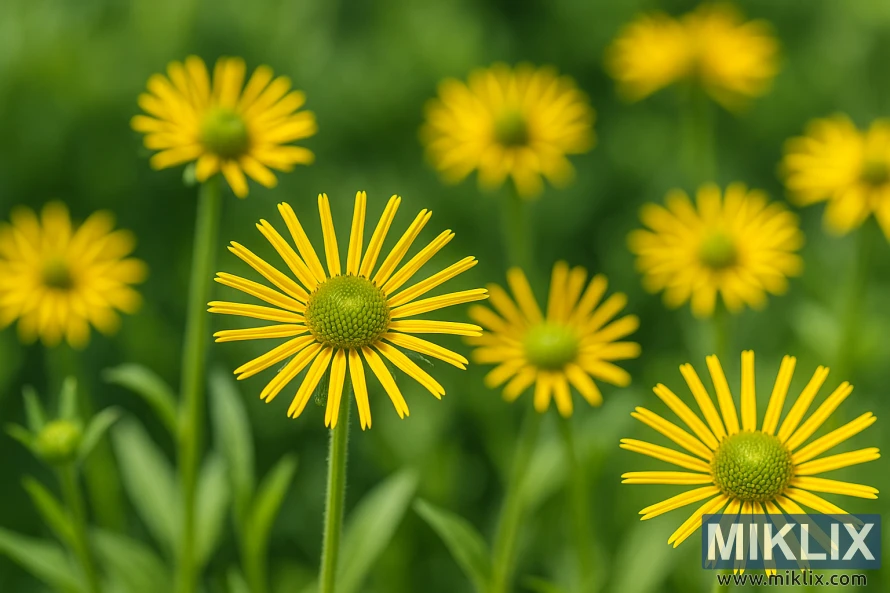
6. 'Little Goldstar' (Rudbeckia fulgida)
Perfect for smaller gardens, 'Little Goldstar' is a compact version of the classic 'Goldsturm' that packs just as much punch in a smaller package. This dwarf variety forms neat mounds just 14-16 inches tall and wide, covered with a constellation of 2-inch golden yellow blooms with dark centers.
As a true perennial in zones 4-9, 'Little Goldstar' blooms reliably from midsummer through fall. Its compact size makes it ideal for containers, front borders, and small space gardens. Despite its diminutive stature, it offers the same excellent disease resistance as its larger cousin.
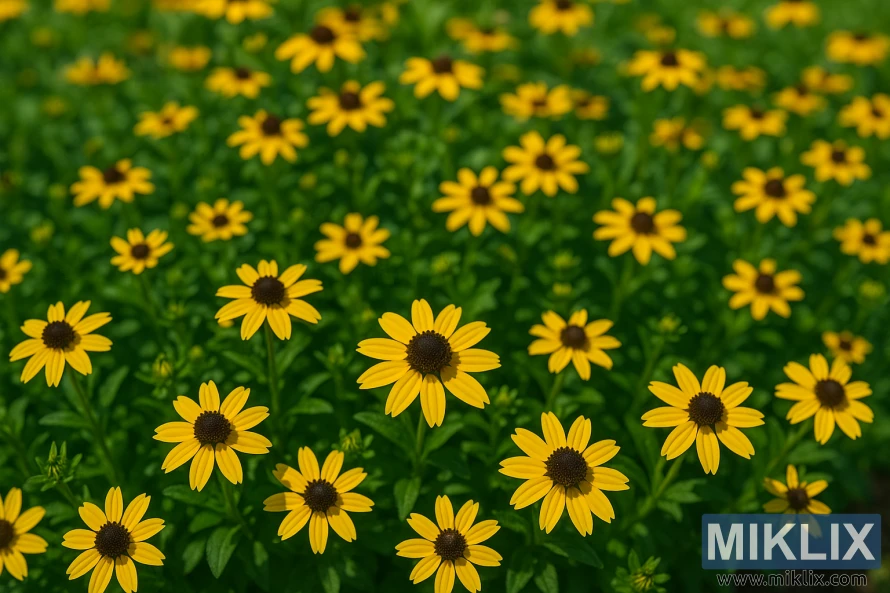
7. 'Sahara' (Rudbeckia hirta)
For gardeners who love vintage color palettes, 'Sahara' offers a stunning array of antique-toned blooms. This unique variety produces semi-double to fully double flowers in muted shades of copper, rose, rusty red, and soft yellow, all with dark centers.
Growing 20-24 inches tall, 'Sahara' is typically grown as an annual but may return as a short-lived perennial in zones 5-9. It blooms from midsummer through fall and makes an exceptional cut flower. The unusual colors blend beautifully with ornamental grasses and other late-season perennials.
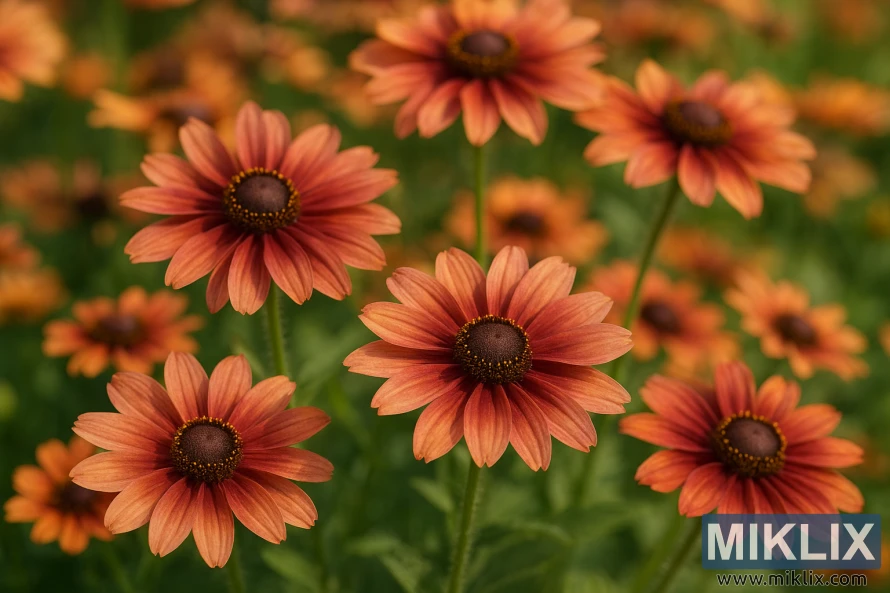
8. 'Chim Chiminee' (Rudbeckia hirta)
Whimsical and eye-catching, 'Chim Chiminee' features unusual quilled or tubular petals that curl inward, creating a distinctive appearance. The flowers appear in a mix of warm colors including yellow, gold, orange, and mahogany, all with dark centers.
Growing 24-30 inches tall, this variety is typically grown as an annual but may return as a short-lived perennial in zones 5-9. It blooms from midsummer through fall and makes a conversation-starting addition to borders and cutting gardens.
Add this whimsical, quilled variety to your garden for something truly different.
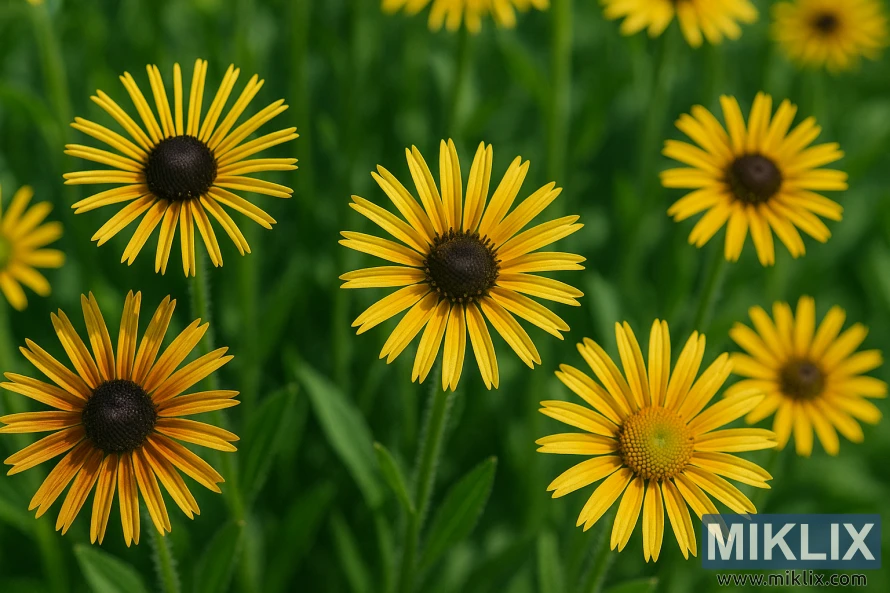
9. 'Irish Eyes' (Rudbeckia hirta)
True to its name, 'Irish Eyes' features cheerful bright yellow petals surrounding a distinctive green center instead of the traditional brown or black. This eye-catching variety grows 24-30 inches tall and produces an abundance of 3-4 inch blooms on strong stems.
Typically grown as an annual but sometimes returning as a short-lived perennial in zones 5-9, 'Irish Eyes' blooms from early summer through fall. It's particularly valuable as a cut flower, with blooms lasting well in arrangements. The plants respond to regular cutting by producing even more flowers.
Add these green-eyed beauties to your cutting garden this season.
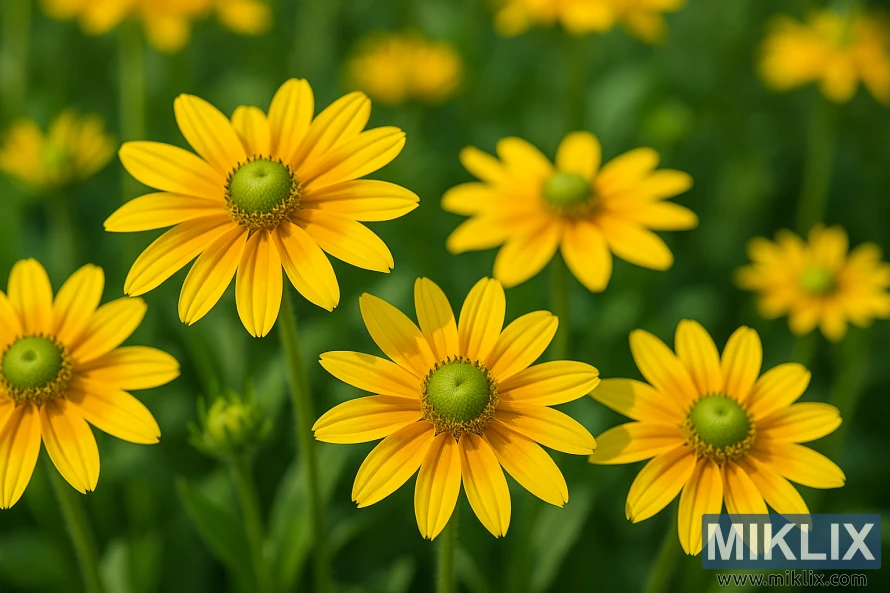
10. 'Autumn Forest' (Rudbeckia hirta)
For dramatic autumn color, 'Autumn Forest' delivers with its large 4-5 inch blooms that feature a stunning color gradient. Each petal starts bright yellow at the tip, transitioning through orange and red to deep mahogany near the black center, creating a sunset-like effect.
Growing 20-24 inches tall, this variety is typically grown as an annual but may return as a short-lived perennial in zones 5-9. It blooms from midsummer through fall and makes an exceptional cut flower. The rich colors are particularly striking when backlit by the late afternoon sun.
Bring autumn's rich palette to your garden with these sunset-hued blooms.
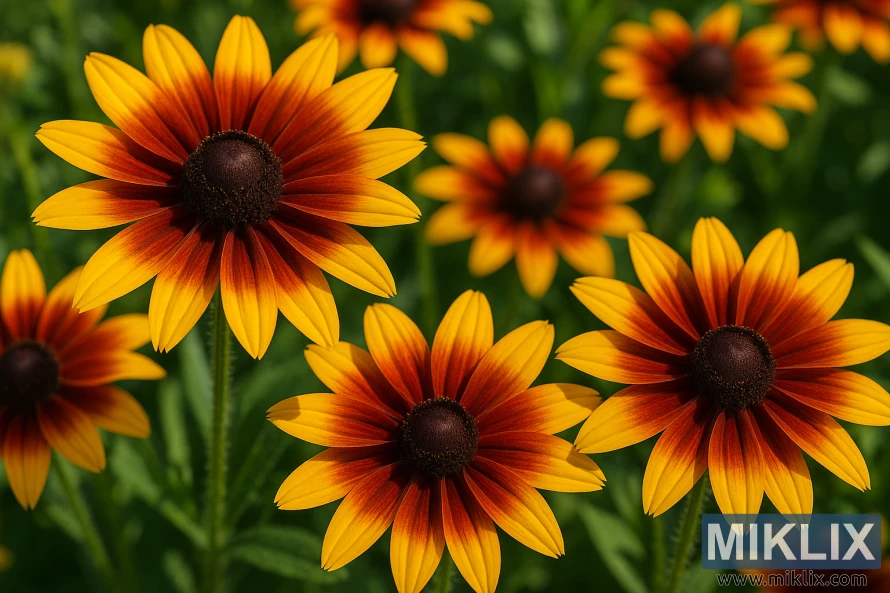
Black-Eyed Susan Varieties Comparison
| Variety | Height | Bloom Color | Bloom Period | Special Features |
| 'Goldsturm' | 24-30" | Golden yellow with black center | July-October | Award-winning, reliable perennial |
| 'Cherokee Sunset' | 24-30" | Mahogany, red, orange, yellow | July-September | Double flowers, sunset colors |
| 'Prairie Sun' | 30-36" | Yellow with light tips, green center | June-September | Unique green center |
| 'Cherry Brandy' | 20-24" | Cherry red to burgundy | July-September | First red Black-Eyed Susan |
| 'Henry Eilers' | 36-60" | Yellow with brown center | August-October | Quilled petals, fragrant |
| 'Little Goldstar' | 14-16" | Golden yellow with black center | July-October | Compact size, abundant blooms |
| 'Sahara' | 20-24" | Copper, rose, rusty red, yellow | July-September | Vintage color palette |
| 'Chim Chiminee' | 24-30" | Yellow, gold, orange, mahogany | July-September | Quilled, tubular petals |
| 'Irish Eyes' | 24-30" | Yellow with green center | June-September | Distinctive green eye |
| 'Autumn Forest' | 20-24" | Yellow, orange, red, mahogany | July-September | Gradient color effect |
Planting and Care Guide
When to Plant
Plant Black-Eyed Susan seeds directly in the garden after the last frost date in spring, or start them indoors 6-8 weeks before your last frost date. Established plants can be transplanted in early spring or fall when temperatures are mild.
How to Plant from Seed
- Prepare the soil by removing weeds and adding compost if needed.
- Sow seeds on the soil surface or barely cover with 1/4 inch of soil, as most varieties need light to germinate.
- Keep soil consistently moist until germination occurs (typically 7-14 days).
- Once seedlings have two sets of true leaves, thin to 12-18 inches apart (spacing varies by variety).
- For fall planting, sow seeds in late autumn and let winter stratification naturally trigger spring germination.
Ongoing Care
Watering
Water regularly until plants are established. Once established, Black-Eyed Susans are drought-tolerant but will perform best with occasional deep watering during extended dry periods.
Fertilizing
Black-Eyed Susans aren't heavy feeders. Apply a thin layer of compost in spring or a light application of balanced, slow-release fertilizer. Avoid excessive fertilizer, which can lead to floppy growth.
Deadheading and Pruning
Deadhead spent flowers regularly to encourage continued blooming. Consider leaving some late-season seedheads for winter interest and to feed birds. Cut back perennial varieties to 4-6 inches above ground level in late fall or early spring.
Winter Care
Most established perennial varieties are winter-hardy in their recommended zones. Apply a light mulch around the crown after the ground freezes to prevent heaving in freeze-thaw cycles.
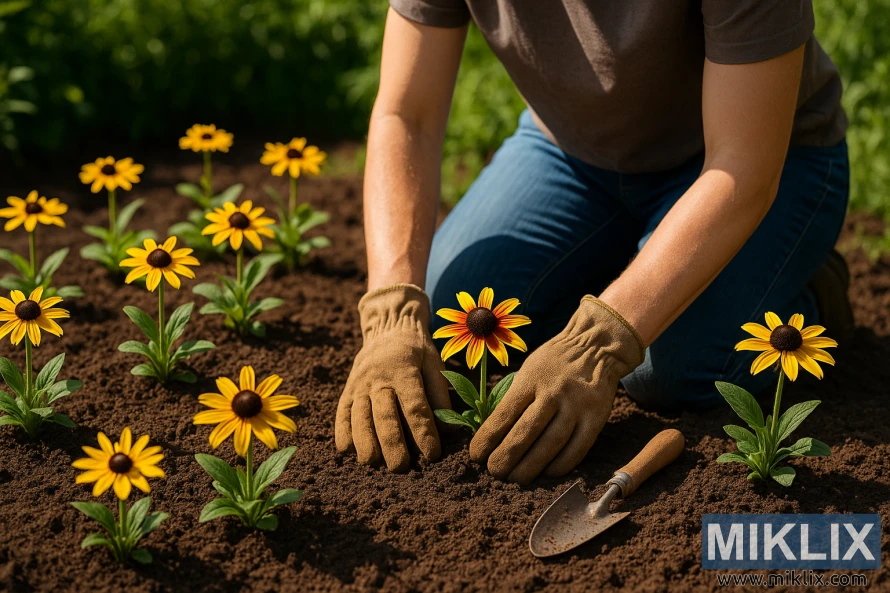
Garden Design Ideas with Black-Eyed Susans
Black-Eyed Susans are versatile garden plants that work beautifully in various design contexts. Here are some inspiring ways to incorporate them into your landscape:
Cottage Gardens
Pair Black-Eyed Susans with other cottage garden favorites like coneflowers, bee balm, and garden phlox. The informal, cheerful nature of Rudbeckias fits perfectly with the relaxed cottage aesthetic.
Prairie-Style Gardens
Create a naturalistic planting by combining Black-Eyed Susans with native grasses like little bluestem or switchgrass. Add other prairie natives like blazing star and goldenrod for an authentic meadow feel.
Cutting Gardens
Plant rows of different Black-Eyed Susan varieties specifically for cutting. Include both early and late-blooming types to extend your harvest season. 'Goldsturm', 'Prairie Sun', and 'Henry Eilers' are particularly good choices.
Perfect Companion Plants
Summer Companions
- Purple Coneflower (Echinacea purpurea)
- Russian Sage (Perovskia atriplicifolia)
- Blazing Star (Liatris spicata)
- Ornamental Grasses (Miscanthus, Panicum)
- Coreopsis (Tickseed)
Fall Companions
- Asters (Symphyotrichum species)
- Goldenrod (Solidago species)
- Joe Pye Weed (Eutrochium purpureum)
- Sedum 'Autumn Joy'
- Blue Mistflower (Conoclinium coelestinum)
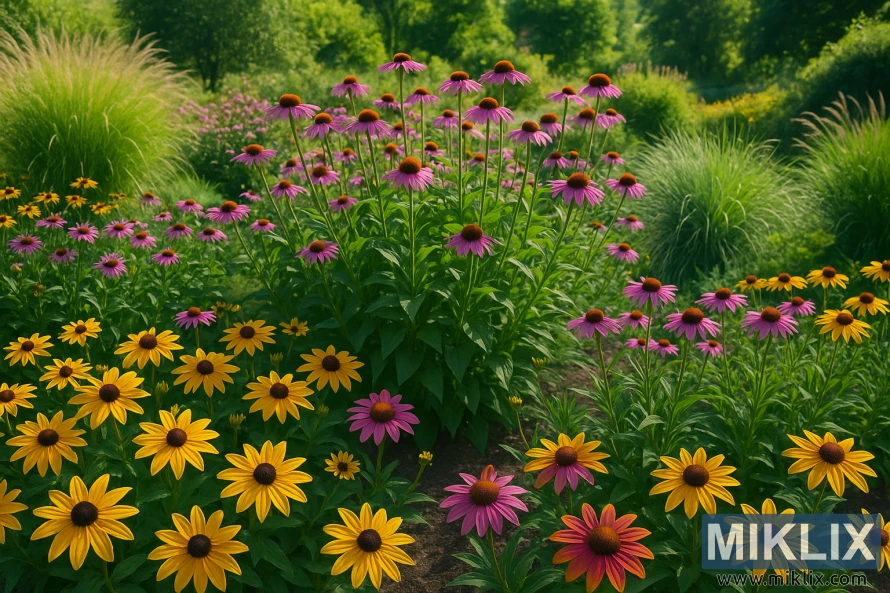
Common Problems and Solutions
Powdery Mildew
This fungal disease appears as a white powdery coating on leaves, typically in humid conditions or when plants have poor air circulation.
Solution: Space plants properly, avoid overhead watering, and remove affected foliage. Resistant varieties like 'Goldsturm' are less susceptible.
Leaf Spot
Various fungal leaf spots can appear as dark spots with yellow halos on foliage, especially in wet conditions.
Solution: Improve air circulation, avoid overhead watering, and remove affected leaves. Apply organic fungicide if severe.
Aphids
These small sap-sucking insects can cluster on stems and the undersides of leaves, causing distorted growth.
Solution: Spray with strong water stream to dislodge, or apply insecticidal soap. Encourage beneficial insects like ladybugs.
Flopping Stems
Tall varieties may flop over, especially after rain or if grown in too much shade.
Solution: Plant in full sun, avoid over-fertilizing, and provide support with stakes or grow-through grids for taller varieties.
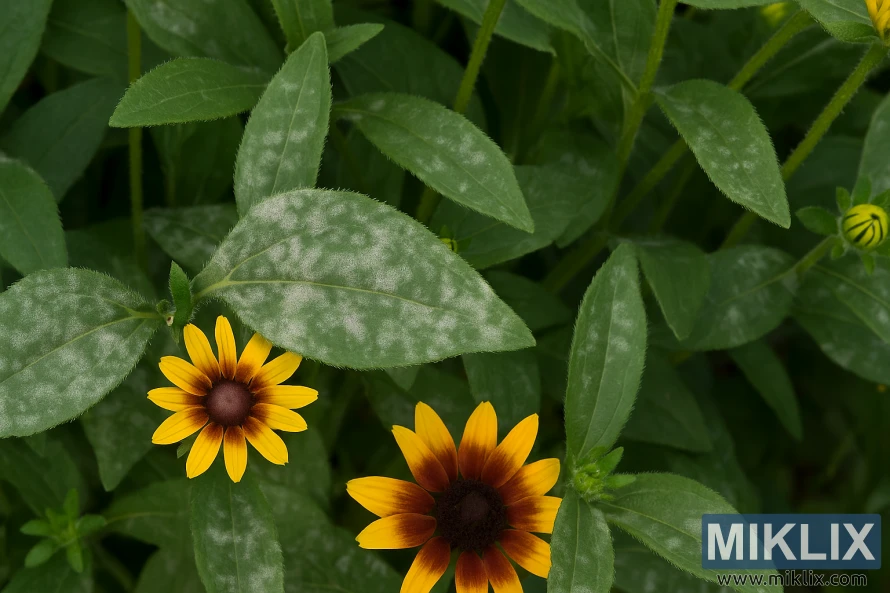
Conclusion
Black-Eyed Susans offer far more variety and beauty than many gardeners realize. From the classic golden-yellow blooms to unexpected colors like cherry red and rusty copper, from compact mounds to statuesque back-of-border specimens, there's a Rudbeckia variety perfect for every garden style and situation.
These resilient native plants reward gardeners with weeks of vibrant blooms while requiring minimal care. They attract pollinators, resist deer browsing, and stand up to summer heat and drought. Whether you're creating a meadow garden, designing a perennial border, or simply looking for reliable flowers for cutting, Black-Eyed Susans deserve a prime spot in your landscape.
Further Reading
If you enjoyed this post, you may also like these suggestions:
- A Guide to the Most Beautiful Zinnia Varieties to Grow in Your Garden
- A Guide to the Most Beautiful Clematis Varieties to Grow in Your Garden
- A Guide to the Most Beautiful Varieties of Bleeding Heart to Grow in Your Garden
